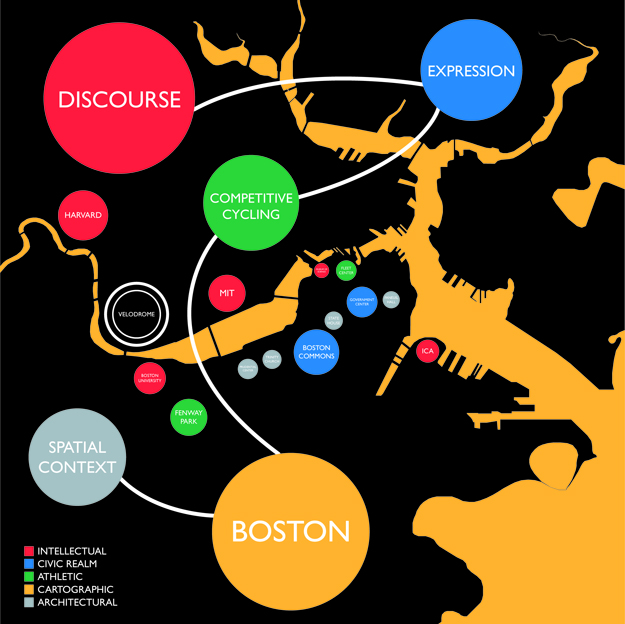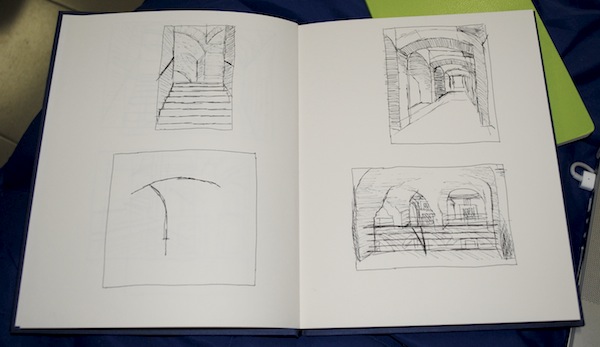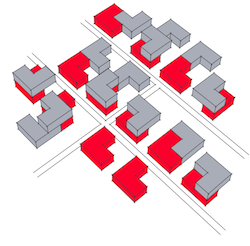As an initial exercise in this first week of comprehensive studio we were charged with writing a critical response to a 2008 Charlie Rose interview with four of today’s leading architects, regarding the way they talk about architecture and the kind of vocabulary they use. The ways architecture is discussed amongst the general public, within the profession, and between the two groups is an interesting study. My response follows:
In Charlie Rose’s hour-long interview with four Pritzker Prize laureates – Jean Nouvel, Zaha Hadid, Frank Gehry, and Renzo Piano – they all speak about architecture as an exploratory process, an adventure of making space in reality and enhancing a contextual dialogue with place. They use expressive words to describe not-only the physical qualities of architecture, but the process, tectonics, and especially relational qualities as well.
As a means of creating architecture, all four agreed on the need for parameters and, similarly, a partner in design – a client. The notion of complete design freedom was not comprehended as a virtuous, or a plausible condition. Through practical criterion and vision of the client [typically], the program is applied and the architectural idea must be maneuvered in, according to Zaha, which challenges creativity. There also needs to be a strategy or vision with civic projects.
This challenge of sustaining an idea through layers of restraint provides direction for realizing and expresses meaning behind an architectural conclusion. For this reason, “clone architecture” is not valued because they often don’t respond to their contextual surroundings.
Interestingly, much of the discussion examines cities and designing new architecture in the urban context. These individuals are often criticized for their buildings because they look different and are unlike most buildings we are used to. How to build relationship with existing buildings without simply reproducing it, is critical to them, which Jean Nouvel expressed almost immediately in the conversation.
Perhaps the most profound difference between architects and non-architects – or, rather, good architects versus bad ones – is their comprehension of building and site relationships without direct interpretation of what is already made.
Renzo Piano speaks romantically of the cities in Italy, made up of layers as if naturally. He sees architecture as fragments of cities, which can provide a diverse context to build upon. Context is beneficial to build from, forcing the design to focus on a smaller angle, assembling a more intense architectural expression. An alliance of time and space stimulates imagination of a building’s enfilade of space, mediating the user experience through architecture. Cinematic influence was especially powerful for Nouvel. The implication of light and space is the tangible language of architecture.
Sustainability was talked about not only in terms of environmental and energy conservation, but livability, social implications and spatial quality as well. Frank believes the mantra of sustainability can be greatly misused to promote a false architectural regard. Zaha continues, that sustainability is ultimately to do with the way space is made and advancements in environmental systems cannot be the sole merit of a building’s essence. Renzo argues that buildings need to breathe and work with the earth.
Good architecture is the exception, despite much contemporary building activity says Frank. “There are very few people like us,” contending their work is not making an impact since the vast majority of new architecture lacks greatness or validity by some standards. The consistency for great buildings is limited because we allow [“bad”] architecture to happen and put up with it.
How to be bold and create a meaningful architecture that is also engaging to the public and societal context, so it may be accepted and celebrated, is the challenge I take away from this discussion. Their focus on civic conditions inspires my thought for designing architecture, regardless of its program, that will be dynamic, respectful, and uplifting to the identity of the city.






 Some of the architects who spoke the day before came for a while and walked around to check on the progress. Nina Maritz talked to us earlier on when we were still clarifying specifics of materials and orientation. Later one Giorgio Goffi stopped by, but only spoke in Italian. He had suggested considering our L-shape as a starting point and how they could be used to create a variety of different sizes and forms. This was not a bad idea, but it made it more difficult to clarify specific decisions regarding solar orientation, tectonics, and of course organization. We attempted to show both ideas – the variation that Goffi suggested, and the more specific possibility of one L. However the new abstract L variety got rid of the original relationship between adjacent units, making several material and orientation decisions less significant. In the end we sort of ran out of time and had a less than stellar presentation – we both agreed it was not good graphically and did not represent our ideas well. But we discussed a lot of interesting strategies during the day, so it was a really good learning experience.
Some of the architects who spoke the day before came for a while and walked around to check on the progress. Nina Maritz talked to us earlier on when we were still clarifying specifics of materials and orientation. Later one Giorgio Goffi stopped by, but only spoke in Italian. He had suggested considering our L-shape as a starting point and how they could be used to create a variety of different sizes and forms. This was not a bad idea, but it made it more difficult to clarify specific decisions regarding solar orientation, tectonics, and of course organization. We attempted to show both ideas – the variation that Goffi suggested, and the more specific possibility of one L. However the new abstract L variety got rid of the original relationship between adjacent units, making several material and orientation decisions less significant. In the end we sort of ran out of time and had a less than stellar presentation – we both agreed it was not good graphically and did not represent our ideas well. But we discussed a lot of interesting strategies during the day, so it was a really good learning experience.